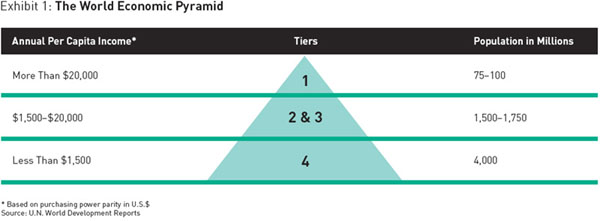What is the BoP?
The phrase "Base of the Pyramid" is used for two interrelated concepts:
- a socio-economic designation for the 4-5 billion individuals that live primarily in developing countries and whose annual per capita incomes fall below $1,500 (in PPP terms); and
- an emerging field of business strategy that focuses on products, services, and enterprises to serve people throughout the base of the world's income pyramid.
Both concepts are also often referred to as the "Bottom of the Pyramid" or the "BoP".

"The Fortune at the Bottom of the Pyramid" by CK Prahalad and Stuart L. Hart, strategy+business, issue26, first quarter 2002
BoP as demographics
As you can see above, a pyramid (a triangle really) is used to approximate the distribution of world income levels. The pyramid's vertical axis relates annual income levels (equalized by purchasing power parity) and the horizontal axis relates to population levels. So, for example, the pyramid's fatter base and narrower tip demonstrates that there are significantly more people making only $2 per day than people making $2000 per day. As a demographic, the BoP has been subject to a number of development initiatives over the past half-century, with these largely philanthropic efforts attempting to improve the quality of life for people in the BoP.
In the end, the BoP is a relative term, even in societies where per dollar income is high, people lower in the economic pyramid still can lack access to services or opportunities. Materially, a person living in the BoP of Kenya may look very different from a person in the BoP of the United States, but in both cases inequalities in opportunities, power, and voice exist.
BoP as strategy
BoP business strategy focuses on approaches by which companies can both begin to serve these demographics and do so in a way that is profitable and growth-oriented. Although much BoP strategy is focused on the efforts of more-affluent outsiders engaging BoP markets, it's important to note that a huge amount of both formal and informal commerce already exists among BoP populations (by some estimates, upwards to $5 trillion dollars a year), and that there also exist a countless number of local enterprises serving them. This distinction could divide BoP strategy into two areas then:
- down pyramid strategy which focuses on firms or individuals from higher up the income pyramid reaching down to work with BoP populations; and
- up pyramid strategies focused on native or "born in the BoP" individuals or enterprises that grew up out of BoP populations themselves.
The next few pages provide some background history for the BoP, reasons most firms are getting excited about it, as well as early challenges and current developments.
- The Forgotten Man - an early history of the BoP
- A Call to Fortune - the work of Stuart Hart and CK Prahalad
- Criticisms and Developments - Criticisms and developments in the BoP



